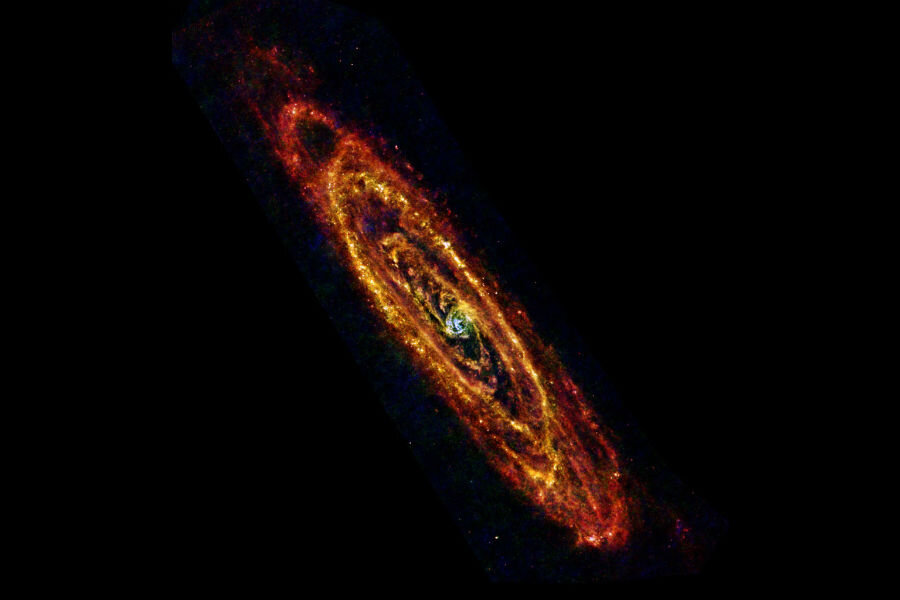Do X-rays from distant galaxies offer first look at dark matter?
Loading...
For more than 75 years, scientists have been trying to solve the mystery of dark matter. It makes up some 84 percent of all the matter in the universe. It forms the very webbing of the cosmos, along whose intersecting strands and sheets galaxies and clusters of galaxies form. But so far, astronomers can only infer its presence by the influence its gravity has on the structures they can directly detect.
Now, a team of astronomers in Europe reports detecting X-ray emissions from the Andromeda galaxy and from the Perseus galaxy cluster that could be a more definitive signature of dark matter – one that also would yield clues about what dark matter is made of.
The results, set to appear next week in the journal Physical Review Letters, appear to bolster the case that dark matter is revealing itself through unique X-ray emissions, emissions initially uncovered by a team led by Esra Bulbul, a post-doctoral fellow at the Harvard-Smithsonian Center for Astrophysics in Cambridge, Mass.
Her team looked at X-ray data from 73 galaxy clusters that had been observed using the European Space Agency's XMM-Newton orbiting x-ray observatory. Their quarry: a hypothesized particle known as a sterile neutrino, the dark-matter counterpart to neutrinos physicists have uncovered in the realm of ordinary matter.
Theory suggests that sterile neutrinos decay to yield X-rays, along with more-familiar forms of neutrinos. These X-rays would carry energy within a specific range. Previous attempts to spot them only were able to establish an upper limit to this range.
The team's hunt uncovered weak X-ray emissions with energies that fell well within the predicted range and that they said were hard to explain if one invoked typical physical processes known to occur in galaxies or galaxy clusters. The emission appeared after they combined the X-ray data for all 73 galaxies. It also appeared when the researchers looked only at subsets of the total collection. That study appeared in The Astrophysical Journal in July.
The study set for publication next week describes similar X-ray emissions from Andromeda, some 2.5 million light-years away, and the Perseus Cluster, 250 million light-years away.
The team undertaking the work, led by Oleg Ruchayskiy and Alexey Boyarsky at Leiden University's Laboratory of Particle Physics and Astrophysics in the Netherlands, says it also has looked at data from the Milky Way's core and found the X-ray signature there as well – and at an intensity they say corresponds to the high concentration of dark matter expected in the galaxy's core.
The detections "may lead to construction of new telescopes specially designed for studying the signals form dark-matter particles," Dr. Boyarsky said in a prepared statement.
Although the work would appear to confirm the study Dr. Bulbul and colleagues published, the jury is still out on a dark-matter origin for the emissions, she cautions in an interview.
Shortly after her team's study appeared in July, another group tried the approach and couldn't find the X-ray signature. Given the flurry of interest greeting the results published in July, the August study's results "were a bit depressing," she acknowledges.
That group, led by Michael Anderson at the Max Planck Institute for Astrophysics in Germany stacked data gathered by NASA's Chandra X-ray Observatory covering 81 galaxies and by XMM-Newton covering 89 galaxies and found no significant evidence for the emissions Bulbul and others have reported detecting.
Even so, other dark-matter candidate particles could be at play, she notes.
Still, the intriguing X-ray signature has appeared in six different cosmic settings, using different detectors on orbit, she notes. This all but rules out the possibility that the signatures are due to detector problems. And another group appears to have found tentative evidence for a sterile-neutrino decay signal in gamma rays.
Even if the signature turns out to be unrelated to dark matter, it will still be interesting, Bulbul holds, since no one had detected galaxy-related X-ray emissions at the energy level she and others have observed.
More detailed evidence for or against a dark-matter explanation will come with the launch of Japan's ASTRO-H X-ray telescope in 2016, she says. In the meantime, her team is wading through additional archived X-ray observations covering different parts of the sky in hopes of finding more of what could be an initial peek beneath dark matter's veil.








